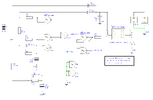ThomsCircuit
Well-Known Member
Two things. Firstly, do not connect the outputs of U2c or U2d to anything. Unused inputs on CMOS ICs are bad, but unused outputs don't matter. Connecting them as you have will lead to more power dissipation.
Secondly, I suggest that you have the power supply to U1 and U2 separate from the power supply to M1. Either fit two more diodes from the two inputs to feed U1 and U2, or have a diode from the supply to M1 and feed the U1 and U2 from that diode. Have another capacitor for U1 and U2. That way the supply for U1 and U2 will continue if the supply for M1 drops when both lights are off.
A final suggestion would be to feed the logic inputs, U1a, U1c, R4 and R5 via diodes from the inputs. Without that the circuit will fail instantly if the polarity is wrong.
Please let me know what I have missed.
Last edited:


